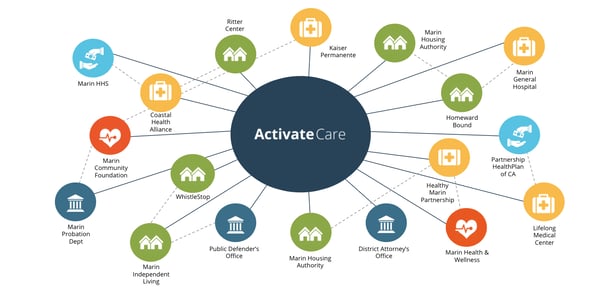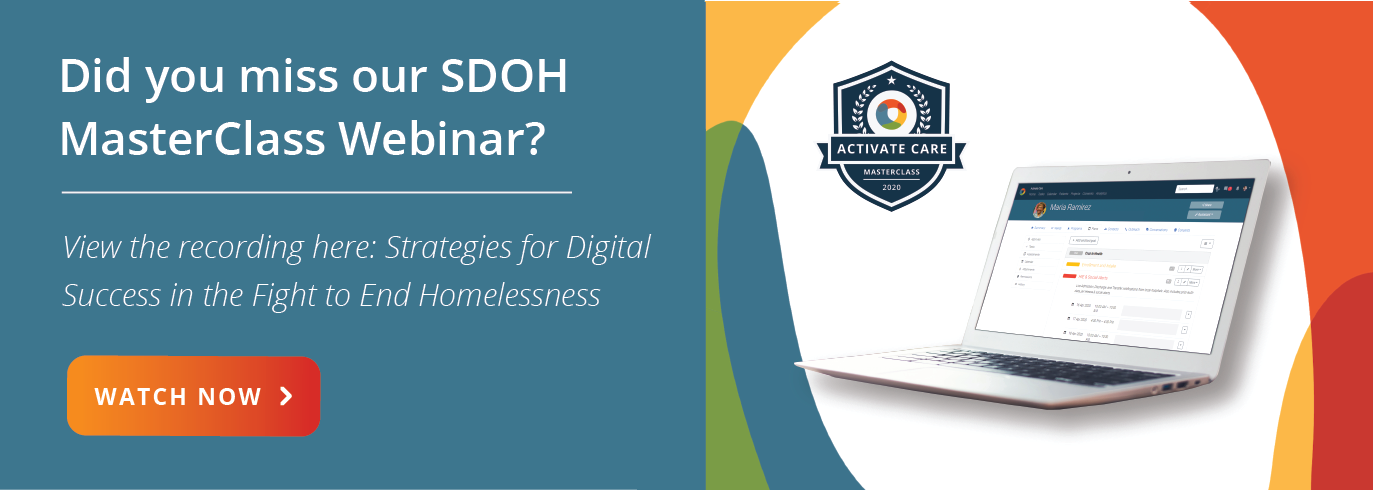Care teams are out in their communities every day, making an impact on those they serve. In the SDOH field, many organizations are working together to achieve shared goals such as improved health and reduced utilization of services such as health care and the criminal justice system.
Below is an example of a network of organizations that are working together in Marin County, California. The state’s Whole Person Care program unifies local health and social care organizations around a common goal: to reduce and, in some counties, to eliminate homelessness. This diagram shows the many organizations engaged in this effort, encompassing healthcare, behavioral health, social services, criminal justice, and homeless services. These types of multisector collaborative programs complicate the measurement and data collection challenge.
 Marin County’s integrated network of health and social care organization
Marin County’s integrated network of health and social care organization
How data can help us achieve our mission:
- It can help your organization deliver a bigger impact by providing real-time data about how well you’re achieving your goals, what is working, and what is not working.
- It can help your organization gain more funding so you can serve more people, by making your team more efficient and helping you capture all appropriate reimbursable activities.
- Evaluations also help you demonstrate your value to funders and policymakers.
However, often the technology platforms used do not give the organizations the data they need to track their programs’ activities and impact in real time because the platforms were generally organized around billing. More often than not, tracking activities and outcomes for funders becomes a cumbersome burden on resource-strapped teams rather than a help for teams trying to make a difference.
Make sure you can measure your work and its outcomes
The most important thing to do for evaluation is to make sure that all the important work your teams carry out can be measured. Many technology systems are initially set up with just billing in mind, and generally only for medical procedures. This is one reason why it has been so hard to track your work in the social field. Technology tools can now help you see whether you’re able to achieve the desired outcomes and if they contribute to the overall impact that funders are looking for. The Activate Care platform is set up to make it easy for you to see if you’re driving value through your activities. You can track progress towards goals, such as finding housing, and you can integrate with HIEs to track outcomes on measures such as hospital utilization or criminal justice involvement.
 Sample record in Activate Care’s community health software platform
Sample record in Activate Care’s community health software platform
Be brave: be a learning organization
The data produced by our work calls us to be brave. One source to fuel this bravery is the recognition that we are doing this work so we can improve people’s lives. Your program evaluation may not yield the results you hope for. This is all part of being a learning organization. An organization that learns that its methods aren't having as big an impact as they hope can tweak those methods. Good funders are understanding of that and will be impressed if you do an evaluation and learn from it.
So, in conclusion, with the technology we now have available in the SDOH field, data can now be our friend. We all want to serve more people and to serve them better. Now, like never before, we have the ability to obtain data from the amazing work being done by everyone in our field - from care coordinators to CEOs. It is an incredible opportunity for the SDOH field.
